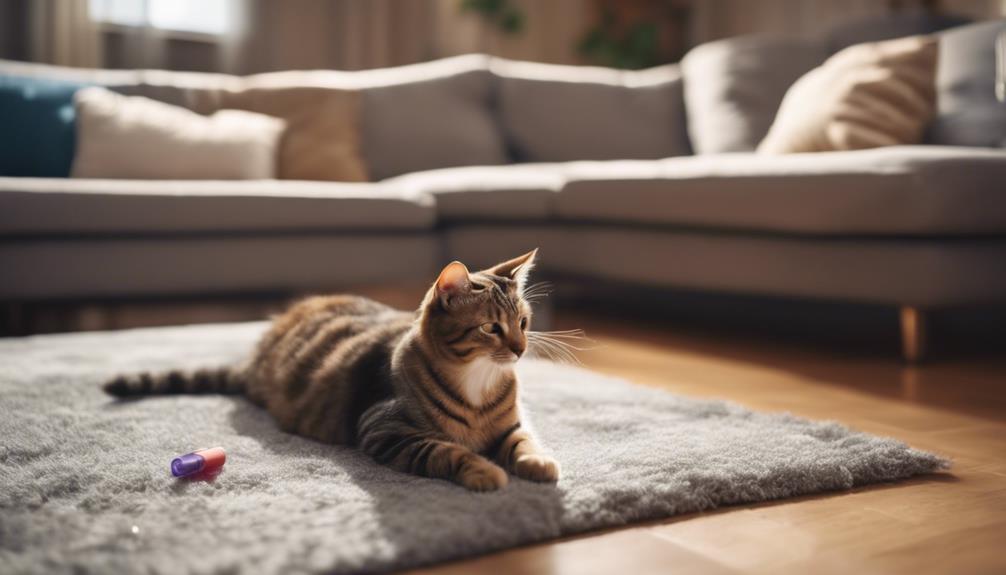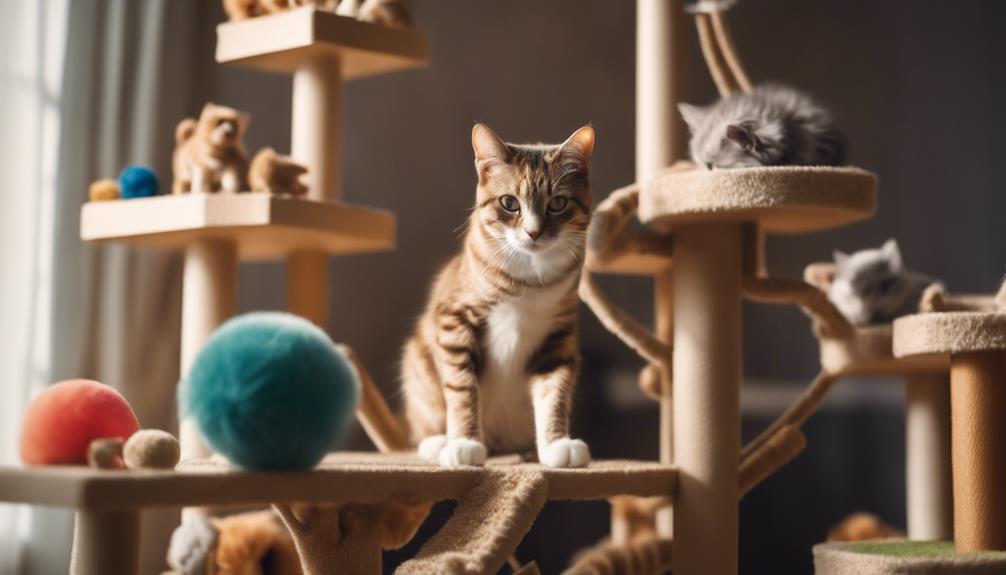In the battle of cat versus couch, the age-old struggle of redirecting feline scratching behaviors looms large for many pet owners. With sofas bearing the brunt of this natural instinct, finding effective solutions becomes paramount in maintaining a harmonious living space.
By exploring practical tips and strategies tailored to address this common dilemma, cat guardians can equip themselves with the necessary tools to safeguard their furniture while nurturing a positive relationship with their whiskered companions.
From understanding the root causes of scratching to implementing proactive measures, the journey towards a scratch-free abode beckons those seeking solace in the face of frayed upholstery.
Key Takeaways
- Understand cat scratching benefits for effective redirection.
- Implement furniture protection strategies to deter scratching.
- Use spray deterrents and positive reinforcement for behavior redirection.
- Provide engaging scratching alternatives to save your furniture.
Understanding Cat Scratching Benefits
Frequently misunderstood, cat scratching serves as a multifunctional behavior that provides numerous benefits to felines beyond just maintaining their claws. Cats use scratching as a form of exercise, helping to stretch their muscles and keep them agile. This behavior also offers mental stimulation, reducing stress and boredom.
Furniture Protection Strategies
To safeguard your furniture from cat scratching damage, implementing effective protection strategies is essential.
One method is to use old blankets or towels to cover the surfaces most prone to scratching. Cats often dislike the texture and will be deterred from scratching.
Alternatively, trying foil or sticky tape on furniture corners can also discourage scratching behavior.
It's important to prevent direct scratching on furniture by providing appealing scratching posts nearby. By offering appropriate alternatives, you can redirect your cat's natural scratching instincts away from your valuable furniture.
Spray Deterrent for Cats

Using a cat-safe spray deterrent on furniture can effectively discourage unwanted scratching behavior in cats. These sprays typically have odors that cats find unpleasant, deterring them from scratching in treated areas.
When applying the deterrent, ensure it is safe for cats and won't harm your furniture. It's essential to follow the manufacturer's instructions carefully to achieve the best results.
Consistency is key when using spray deterrents, as cats may need repeated exposure to the unpleasant scent to learn that scratching in that area is undesirable. Remember to pair this method with positive reinforcement for using appropriate scratching surfaces to redirect your cat's behavior effectively.
Providing Scratching Alternatives
When redirecting your cat's scratching behavior, it is crucial to provide appropriate scratching alternatives that cater to their natural instincts and preferences. Placing cat scratchers next to favorite spots, offering variety in scratcher types and materials, and experimenting to find preferred scratching options are effective strategies. By providing these alternatives, you can help steer your cat away from damaging furniture and redirect their scratching behavior in a positive and fulfilling way.
| Scratching Alternatives | Description |
|---|---|
| Cat Scratching Posts | Vertical posts for stretching and marking |
| Cardboard Scratchers | Horizontal surfaces for nail grooming |
| Sisal Rope Scratchers | Durable material for satisfying scratches |
Keeping Cats Busy and Engaged

Engaging cats in stimulating activities throughout the day is essential for maintaining their overall well-being and preventing destructive behaviors like excessive scratching. Providing interactive toys that mimic hunting behaviors can keep cats mentally engaged and physically active.
Toys like feather wands, laser pointers, and puzzle feeders are great options to keep cats entertained and stimulated. Daily playtime sessions, where you actively engage with your cat using toys or even simple household items like crumpled paper or cardboard boxes, can help prevent boredom-related scratching.
Rotating toys and introducing new ones periodically can also keep your cat's interest piqued. Keeping cats busy and engaged not only redirects their energy away from furniture but also strengthens the bond between you and your feline companion.
Nail Maintenance Tips
Regular nail maintenance is crucial in reducing potential damage caused by cat scratching and is an integral part of overall furniture protection strategies. Keeping your cat's nails short helps minimize the impact of scratching on furniture, as shorter nails are less likely to cause significant damage.
To maintain your cat's nails at an appropriate length, regular trimming is essential. Invest in high-quality nail clippers designed specifically for cats and make nail trimming a part of your routine pet care. If you are unsure about how to trim your cat's nails safely, consult your veterinarian or a professional groomer for guidance.
Conclusion
In the intricate dance of cat scratching, understanding the feline mind is the key to harmony. By providing appropriate outlets for this natural behavior, such as scratching posts and engaging activities, you can save your furniture and nurture your cat's well-being.
Like a delicate balance of light and shadow, redirecting scratching behaviors can lead to a harmonious coexistence where both feline and human can thrive in unison.




